

Warriors
Xian, China
photographed June 2005
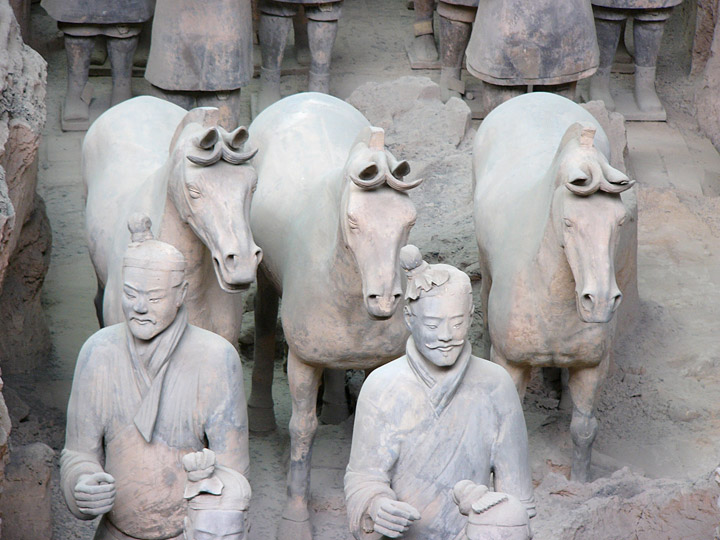
the terracotta warriors
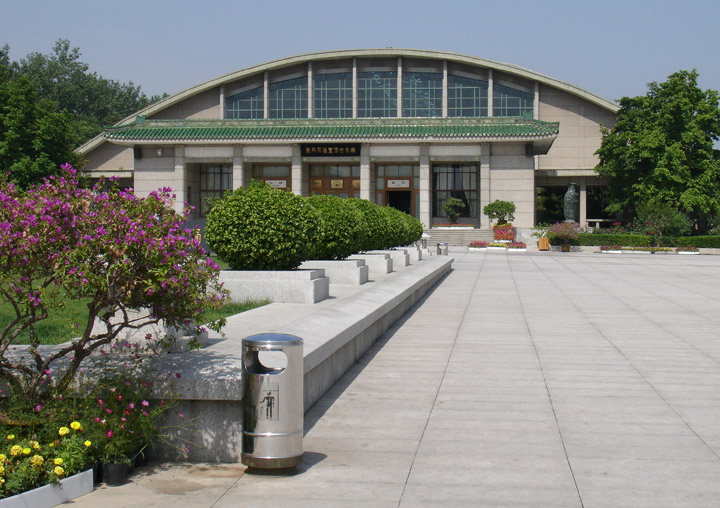
entrance to Pit 1
In March, 1974, the villagers from Xiyang Village of Yanzhai Township in Lintong District accidentally discovered many broken pottery figures while sinking a well 1.5 kilo-meters away east of Emperor Qin Shihuang's Mausoleum.
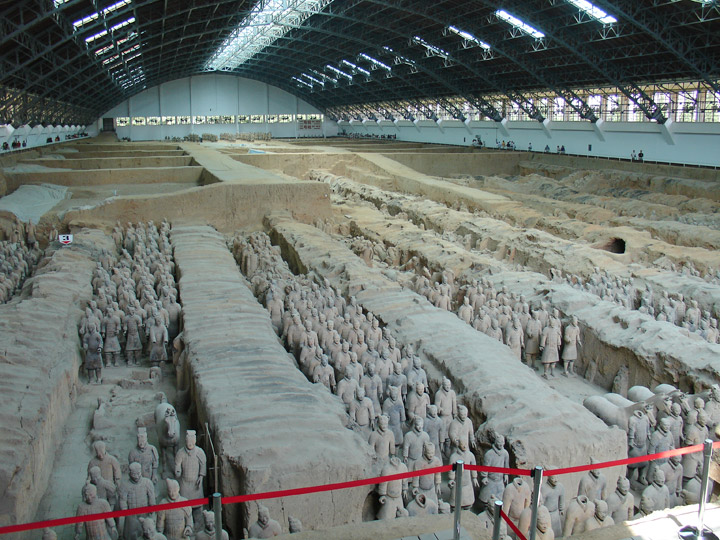
Pit 1
After archaeological excavation and textual research, it was found that this was an oblong pit in which were buried terra-cotta warriors and horses from the Qin Dynasty. In 1976, after drilling, another two pits were discovered respectively 20 meters and 25 meters north of the former one. They were numbered Pit 1, 2 and 3 respectively in order of discovery, with a total area of 22,780 square meters.
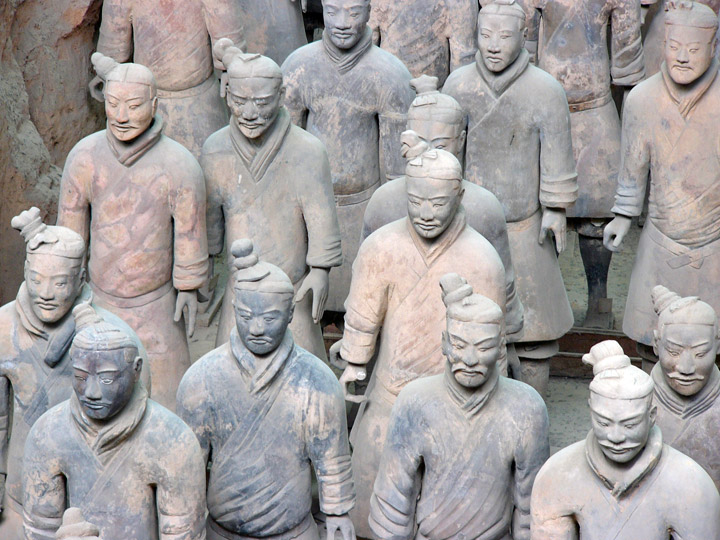
warriors in Pit 1
This new discovery stirred up a sensation across the whole world. In order to protect properly those rare but valuable historical relics, in 1975, the State Council gave permission that a museum covering an area of 16,300 square meters be constructed on the site of Pit No. 1. The museum was officially open to the public on October 1, 1979. The exhibition hall of Pit No. 3 was open to the public on September 27, 1989. The exhibition hall of Pit No. 2 was also open to the public in October, 1994. The museum and the mausoleum are listed as one of the ten historical places in China and they are also placed by the UNESCO among the world's cultural legacies.
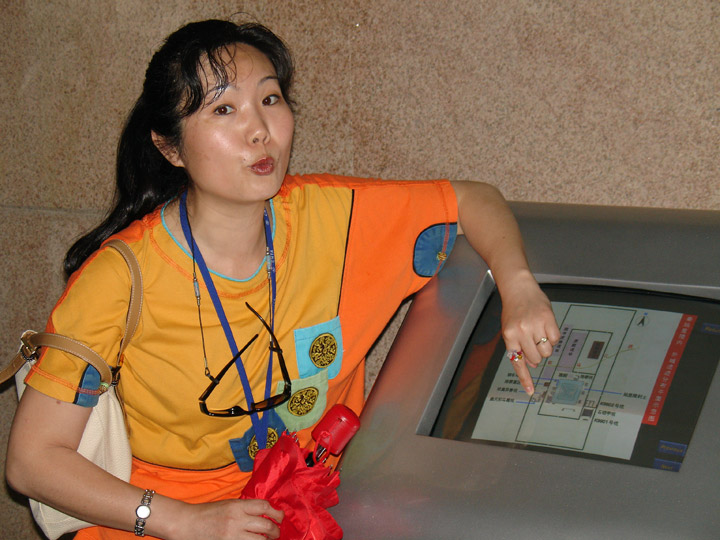
guide using a computer model to explain the Museums
Pit No. 1 is in an oblong shape, 230 meters long from east to west, 62 meters wide from north to south and 5 meters deep, covering an area of 14,260 square meters. It is an earth-and-wood structure in the shape of a tunnel. There are five sloping entrances on the eastern and western sides of the pit respectively. Down inside the tunnel, there are ten earth-rammed partition walls, across which huge and strong rafters were placed, then covered with mats and fine soil and filling earth. The floors are paved with bricks. The terra-cotta warriors and horses in Pit No. 1 are arrayed in a practical battle formation. In the long corridor to the east end of the pit stand facing east three rows of terra-cotta warriors in battle tunics and puttees, 70 in each, totaling 210 altogether. Armed with bows and arrows, they constitute the vanguard. There is one row of warriors in the south, north and west of the corridor respectively, facing outward. They are probably the flanks and the rear guard. Holding crossbows and arrows and other long-distance shooting weapons, they took up the job of defending the whole battle formation. The ten rammed partition walls divided Pit No. 1 into eleven latitudinal passage ways where stand facing east 38 columns of warriors with horse-drawn chariots in the centre. The warriors, armor-clad, holding long-shaft weapons are probably the main body of the formation and represent the principal force. There are altogether 27 trial trenches. According to the density of the formation in each trial, it is assumed that more than 6,000 clay warriors and horses could be unearthed from Pit No. 1, most of which are infantrymen.
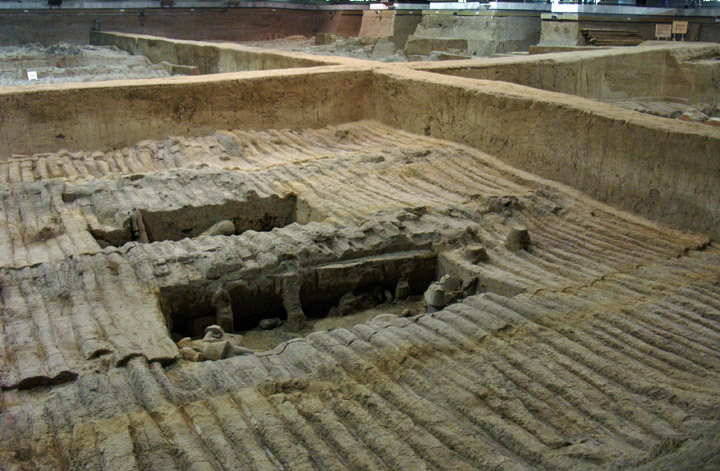
excavations showing the fabric coverings over the rows of warriors
Pit No. 2 is located 20 meters to the north of the eastern end of Pit No. 1. The Pit is L--shaped and consists of four different mixed military forces in four arrays. It is estimated that there were over 1,000 pieces of pottery figures, 500 horse-drawn chariots and saddled horses. The pit is measured 6,000 square meters. The first array, is composed of 334 archers. To the south of the pit is the second array, including the first through the eighth passage ways, it is composed of 64 chariots, each of which carries three warriors. The third array, i.e. the middle of the pit, including the ninth through the eleventh passage ways is composed of 19 chariots and 100 infantrymen. The fourth array to the north of the pit, including the l2th through the 14th passage ways is composed of six chariots, 124 saddled horses and cavalrymen. The four arrays are closely connected to constitute a complete battle formation and can be divided up to act independently, capable of attacking and defending and of self-protection and quick response. Three of the four arrays in Pit No. 2 have chariots and warriors. The chariots took up most of battle formation. This proves that chariots and warriors were the principle fighting forces in the Qin Dynasty. The wooden chariots have become decayed with age, but the tongues and wheels left clear traces in the clay. The bronze parts of the chariots remained intact. Pit No. 3 is located 25 meters to the north of Pit No. i and to the west of Pit No. 2. The plane of the pit is of concave shape totaling about 520 square meters. Out of the pit were unearthed one chariot, four terra-cotta horses and 68 clay armored warriors. To its east, there is a sloping entrance, 11.2 meters long, 3. 7 meters wide, opposite which is a chariot and horse house. On both sides of the house, there is a winging room, in which were unearthed 64 pottery figurines. The arrangement of the pottery figurines is quite different from that in Pits No. 1 and No. 2 in which the warriors are placed in battle formation. But those in Pit No. 3 are arrayed opposite to each other along the walls, in two rows. Even the weapons held by the warriors in Pit No. 3 are different from those in Pits No. 1 and No. 2. The latter were armed with long-range across bows and arrows and short weapons such as spears, barbed spears, swords and axes. In Pit No. 3 were only discovered one kind of weapon called "shu", which had no blades and are believed to be used by the guards of honor. Unearthed also in this pit were a remaining deer-horn and animal bones. This is probably the place where sacrificial offerings and war prayers were practiced. Judging by the layout of Pit No. 3, it is most likely the headquarters directing the mighty underground army.

Enclosure for later excavations
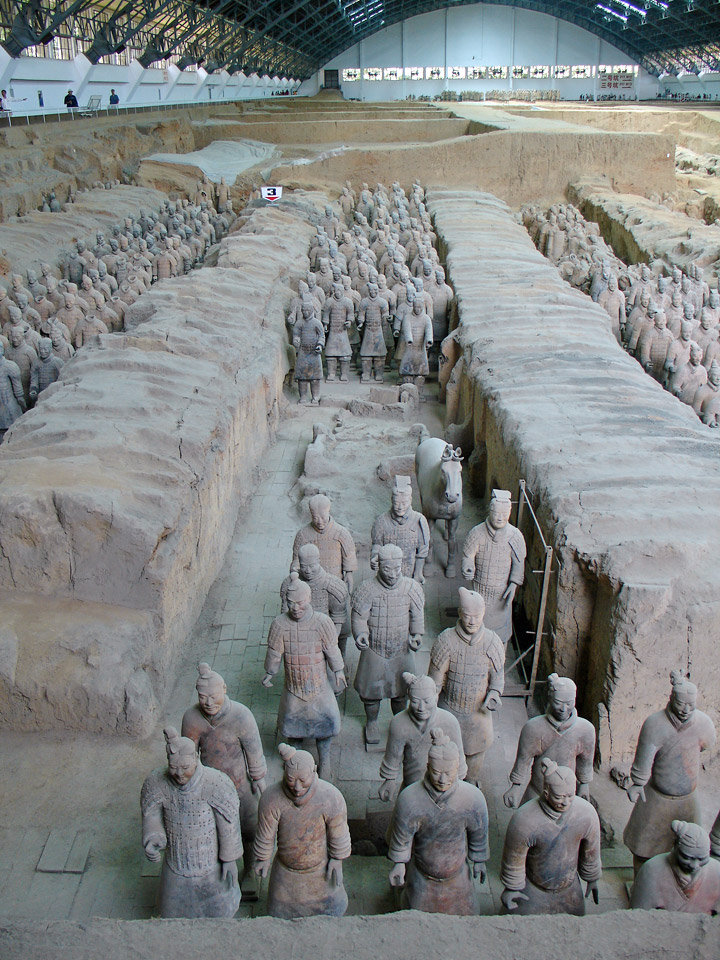
terracotta warriors in Pit 1 1
More Photos of the Excavations
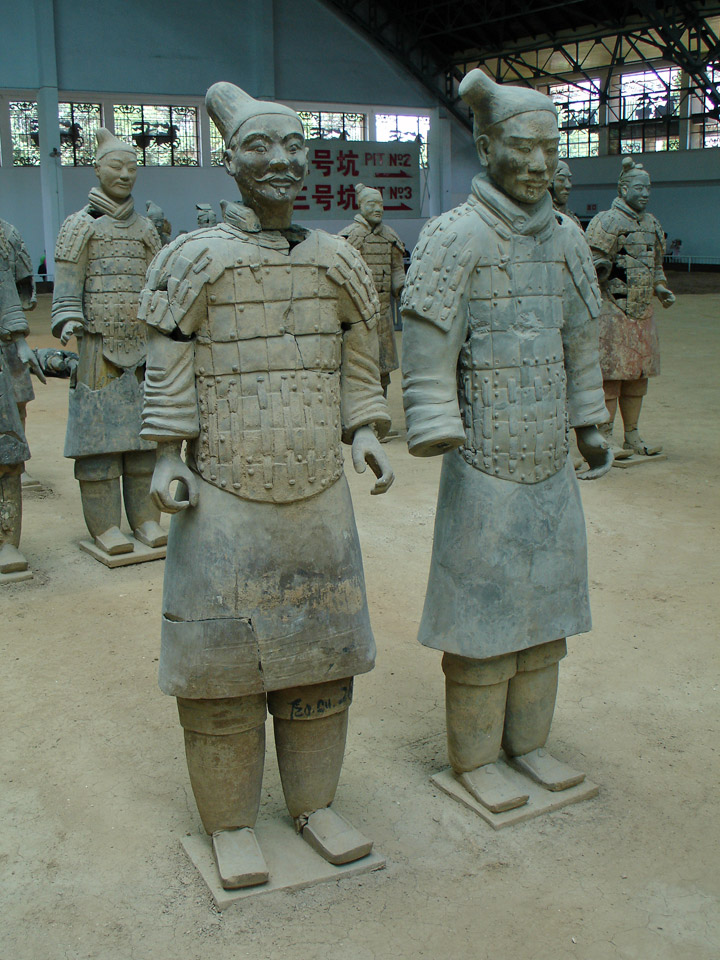
life size terra-cotta warriors s
The height of the terra-cotta warriors varies from 1.78 meters being the
shortest to 1.97 meters being the tallest. Their weights are also different. The
lightest being 110 kilograms and the heaviest 300 kilograms. In order to keep
the balance of the terra-cotta warriors, the workmen in the Qin Dynasty added a
pedal to each warrior under his feet, so that the warriors would stand more
firmly. The foot pedals were made in moms. The feet, shoes, legs and armors of
the warriors were made by hand. Some legs are hollow, some are solid. The solid
ones are made separately, but the hollow ones are made through a method called
"coiled rope of clay". The bodies of the warriors are all hollow, made with the
previously mentioned method. Some are made separately and join the models
together to complete the work. Arms also have two kinds, hollow and solid forms.
The hollow arms are made separately. The making of hands has two ways: molding
and hand-making. The most sophisticated technique of processing is heads. Two
molds are used to make faces and most parts of heads first of all, then join the
two parts together. Ears and noses which are made independently are added later
on. The roughly made models are carved exquisitely in detail according to their
personal strata and characters. Finally moustache and hair in various styles are
made.
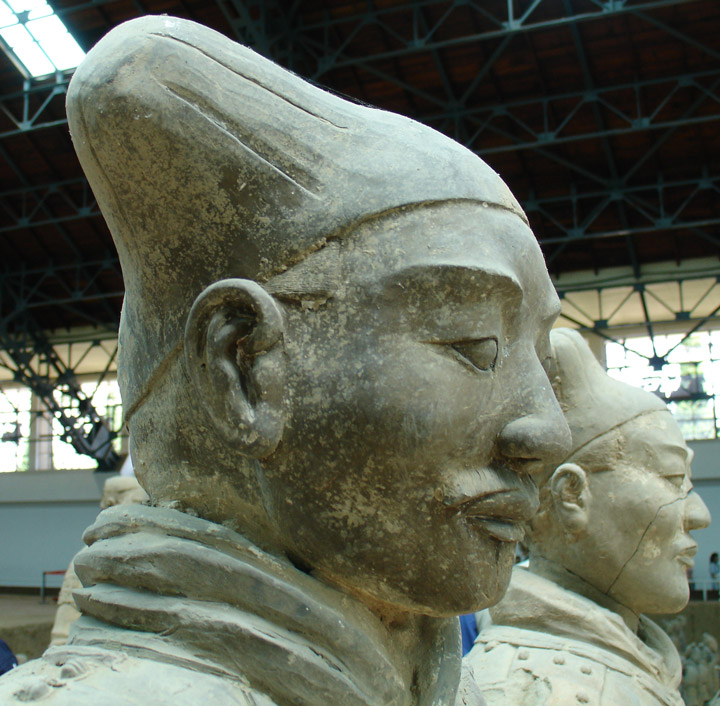
detail of head construction
After careful and detailed engraving by the Qin workmen, the terra-cotta
warriors look vivid, different in appearance and expressions. It is presumed
that these warriors were made according to the real valiant Qin army soldiers by
the Qin workmen. After the terra-cotta warriors were made ready, they were to
put into the kilns to be fired. In order to prevent the warriors from deforming
or exploding, there are one, two or three small holes in the body o{ the
warriors and horses when they were being made. After the horses were fired, the
small holes on the body were covered with pottery cakes of the same size. Most
of the pottery heads were welded with the body after being fired, so the necks
of the pottery warriors were ventilation holes. Thus, the air stream pro-
duced in the firing process of the pottery warriors and horses could escape from
these ventilation holes, and would not explode due to the expansion of hot air
stream.
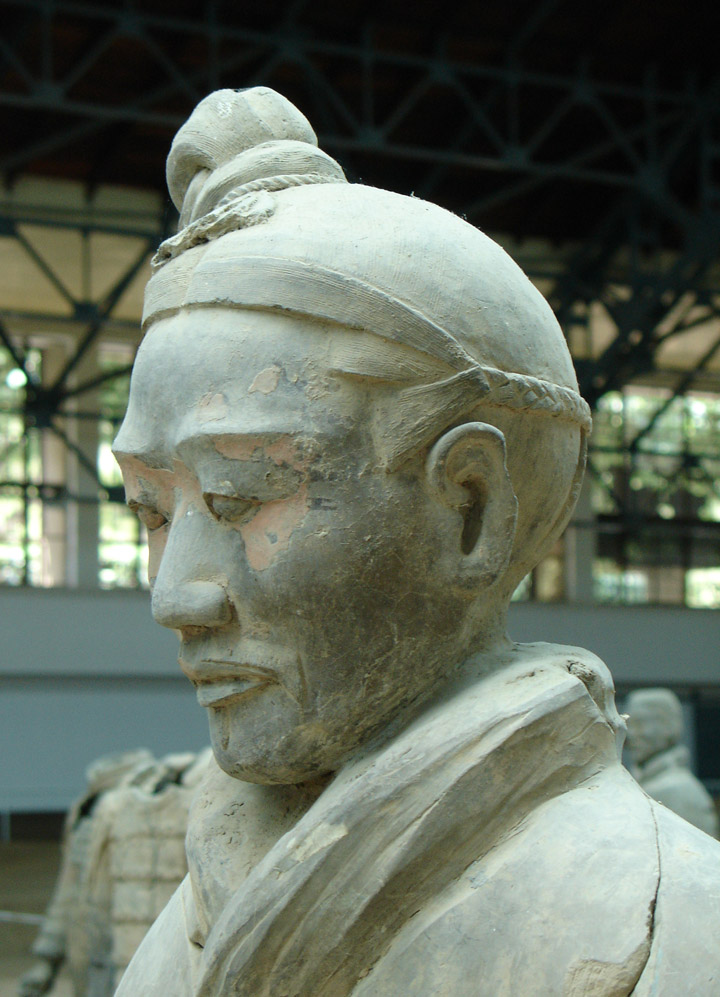
traces of the polychrome original
The clay models were carefully color-painted after they were baked. As
the terra-cotta figures have been burnt and gone through a natural process of
decay, we can't see their original gorgeous colors. However, most of the figures
bear the traces of the original colors, and a few of them are still as bright as
new. They are found to be painted with mineral dye stuffs of red, green, blue,
yellow, purple, brown, white, black, pink, vermilion, etc. This demonstrates
that the Chinese working people produced on a massive scale and used these dye
stuffs extensively over 2000 years ago. It is of great significance not only in
the
history of color-painting art, but also in the history of world science and
technology.
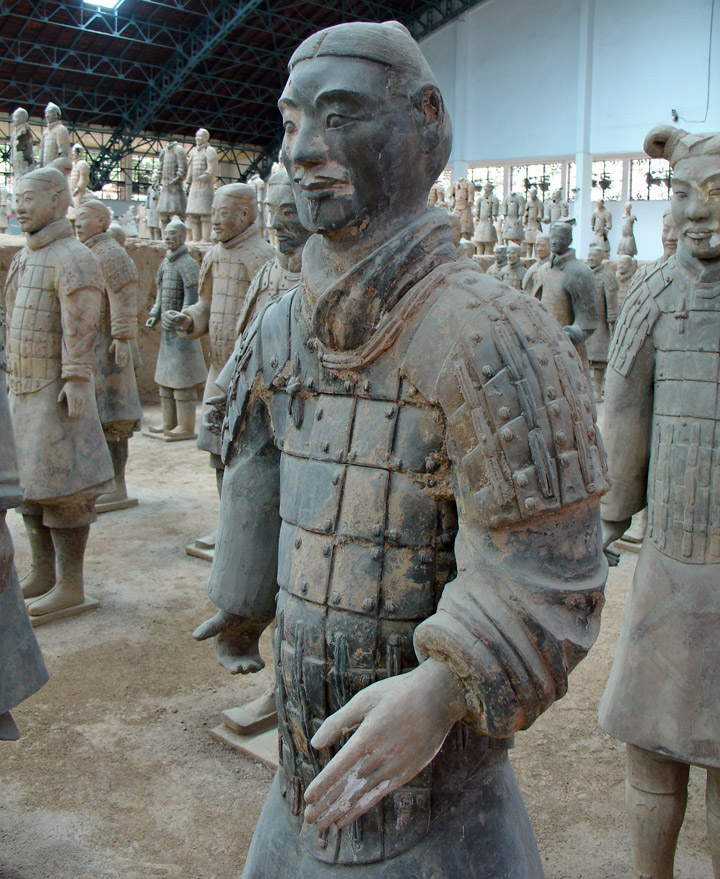
warriors reassembled
The pits are located to the east of Qin Shihuang's Mausoleum, symbolizing the main defending force that guarded the capital, Xianyang. All the pottery figures in the pits held practical weapons, facing east. This shows that Emperor Qin Shihuang would never forget his great ambition to conquer the six states and to unify the whole nation. Thousands of real weapons were unearthed from the pits, including broad knives, swords, spears, daggers, axes, halberds, cross-bows, arrows, and arrow heads. The weapons can be classified into four categories: long-shafted weapons, short weapons, long-range weapons and weapons for guards of honor. They were exquisitely made and enjoyed a high level of casting technology.

the Museum
The most eye-catching among the weapons is a bronze sword, which still glitters
in metallic luster without being rusty, though buried underground for over 2,000
years. Being very sharp, the sword can cut through 20 pieces of paper put
together. Technical examination reveals that the sword is composed of an alloy
of copper and tin, and more than ten other rare metals. It is coated with a thin
layer (10-- 15 micron) of oxidized chromium, which proves that the weapon was
oxidized with chromate in the making. The technology of chromate coating was
invented by a German in 1930's, but in China chromate-coating technique was
employed in the making of weapons over 2,000 years ago.

horse heads
In the pits of terra-cotta warriors and horses were also discovered hundreds of
crossbow triggers whose bolts and suspending knives can be used interchangeably,
with a tolerance error of 1 millimeter. The arrow heads are divided into four
kinds. The outline of the three sides of the arrow heads of the same kind has a
tolerance error of 0. 15 millimeter. From this we can see that the weapon
manufacture was already standardized just to meet the war needs.

four horses
This also shows that the metallurgical technology and weapon making technique had reached a high standard in the Qin Dynasty. In December 1980, two sets of large painted bronze chariots and horses were unearthed 20 meters west of the mount of Emperor Qin Shihuang's Mausoleum. They were listed as No. 1 and No. 2 respectively according to their discovery. They were then enclosed in a wooden coffin and buried in a pit seven meters deep. When excavated, the chariots and horses were seriously damaged due to the decayed wooden coffin and the collapse of earthen layers. No. 2 bronze chariot and horses were found broken into 1,555 pieces when excavated. After two-and-half years of careful and painstaking restoration by archaeologists and other experts, they were formally open to the public on October 1,1983. No. 1 bronze chariot and horses were also open to the public in 1988.

bronze chariot drawn by four horses
The bronze chariots drawn by four horses, with a single shaft, were placed one before the other vertically. The front chariot, i. e. No. 1 Chariot was named "High Chariot". The charioteers and passengers all stood in the chariot. The back chariot, i.e. No. 2 Chariot was named "Security Chariot", and also called "air-conditioned chariot". It has a front room and a back room, between which there is a partition. The front room is for the charioteer and rear one, for the master (emperor). In the rear compartment, there is a window on either side of the carriage as well as in the front with a door at the back. The windows and doors could close and open easily. The small holes on the windows were used for ventilation. On top of the chariot ,there was an elliptical umbrella--like canopy. The chariot was color painted against a white background. No. 2 Chariot was fitted with more than 1,500 pieces of silver and gold and other ornaments, looking luxurious, splendid and graceful. Probably it was used for Emperor Qin Shihuang's soul to go out on inspection. No. 1 Chariot was equipped with crossbows, arrow heads, shields and the charioteer wore a hat, which shows that this chariot was employed to protect the No. 2 Chariot behind.
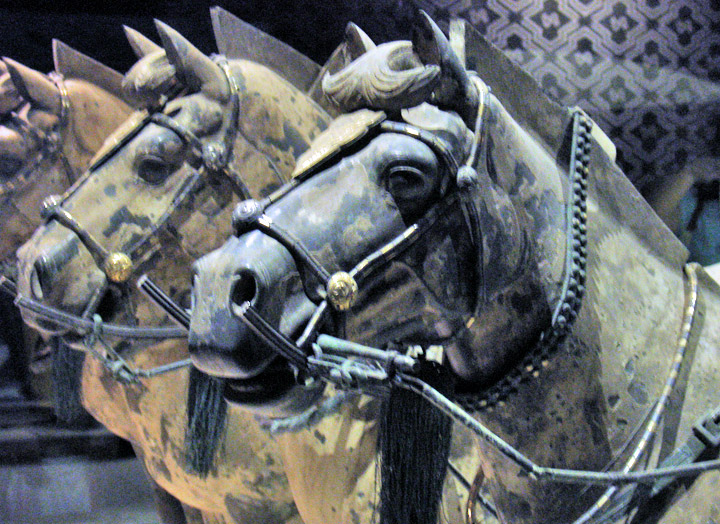
detail of horse ornamentation
The chariots and horses are exact imitations of actual chariot, horse and driver in half life-size. The chariots and horses are composed of 3,400 bits. The bronze chariot is 3.17 meters long, 1.06 meters high. The bronze horse is 65--67 centimeters high, 1. 2 meters long. Their weights vary from 177 kilograms, the lightest, to 212.9 kilograms, the heaviest. The total weight of the chariot, the horse and the driver reach to 1,243 kilograms.
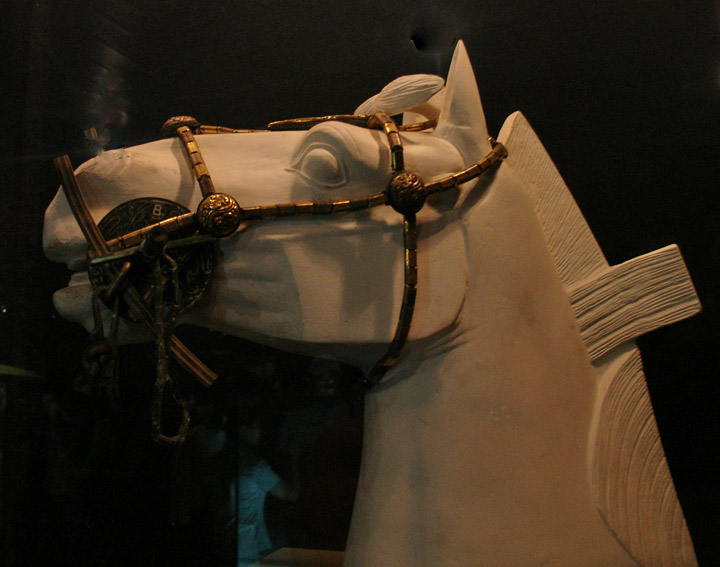
The main body is cast of bronze. There are altogether 1,720 pieces of gold and silver decoration on the chariots and horses, with a total weight of seven kilograms of silver and gold wares. One is compelled to appreciate the high technology, the real artistic modeling in great admiration.
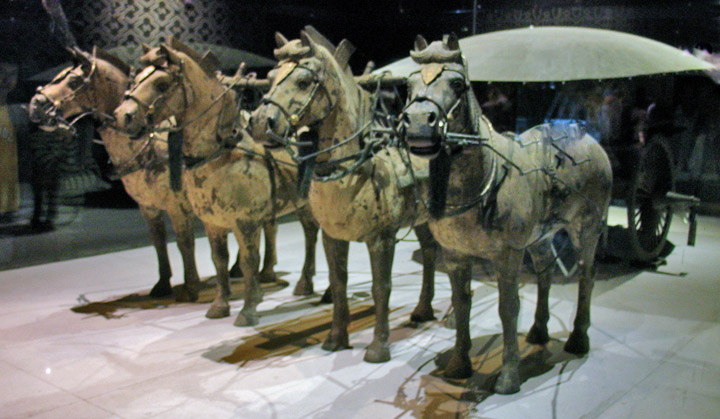
chariot with the umbrella-like canopy on the top
For instance, the umbrella-like canopy on the top is only four millimeter thick, the window one millimeter thick, with many ventilation holes. The horse tassels were made of bronze thread as thin as a hair, the diameter of which is only 0. 1 m. m.. The horse necklets were welded together with 42 nodes of gold and 42 nodes of silver. Archaeologists can see the welding joints only with the help of magnifiers. The horse halters, made of a gold tube and a silver tube, were joined with a form of snap fasteners. In the halters, there is a pin. When the pin was pulled out, the halters could be removed completely. According to primary research, it is found that the making of the bronze chariots and horses involved different techniques such as casting, welding, riveting, mounting, embedding and carving.
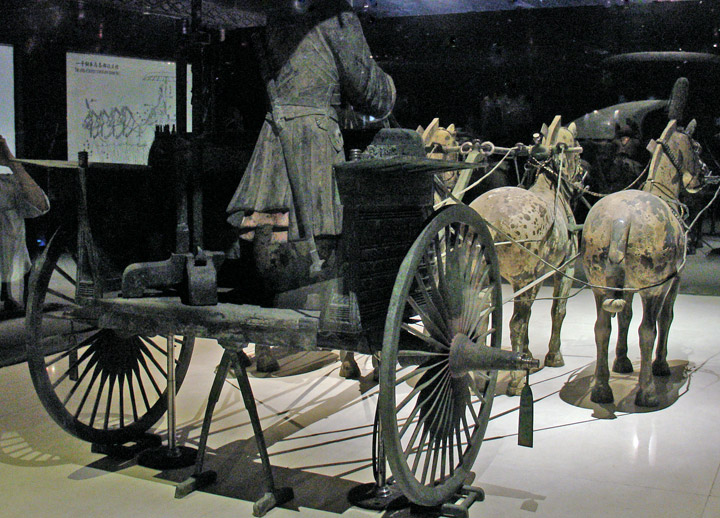
#2 chariot
The bronze chariots and horses were the earliest and most exquisitely made bronze valuables. They enjoy the highest class and have the most complete harnessing wares. They are also the largest bronze ware discovered in the history of world archaeology. The excavation of the bronze chariots and horses provides extremely valuable material and data for the textual research of the metallurgical technique, the mechanism of chariots and technological modeling of the Qin Dynasty.
Text from Wikipedia